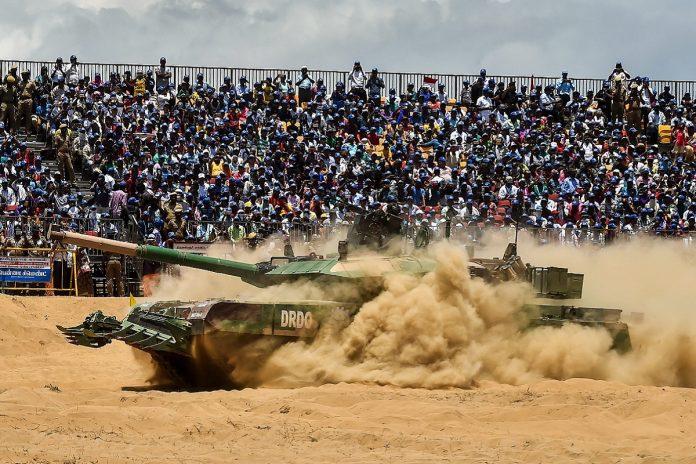Defence: Covering Failures By Creating a New Committee

Image Courtesy: The Print
The Ministry of Defence (MoD) through a notification announced setting up of Defence Planning Committee (DPC) on April 18 with National Security Advisor as its head, Chairman of the Chiefs of Staff Committee, the three service chiefs, the secretaries of Defence, Expenditure and Foreign Affairs and Chairman of Integrated Staff as its member. The committee will submit reports to the Union Minister of Defence. However, DPC will monitor implementation of the decisions taken based on their recommendation. Thereby reducing the role of Ministry of Defence in policy planning and procurement and basically leaving them to do day-to-day chores.
The charter of duties of the DPC has two parts. First one is to “analyse and evaluate all relevant inputs relating to defence planning”, which includes, among others, the “national defence and security priorities, foreign policy imperatives, operational directives and associated requirements, relevant strategic and security-related doctrines, defence acquisition and infrastructure development plans, including the 15-year Long-Term Integrated Perspective Plan (LTIPP), defence technology and development of the Indian defence industry and global technological advancement.”
Second, the DPC is tasked to prepare five different sets of drafts including: “national security strategy, strategic defence review and doctrines; international defence engagement strategy; roadmap to build defence manufacturing eco-system; strategy to boost defence exports; and prioritised capability development plans for the armed forces over different time-frames in consonance with the overall priorities, strategies and likely resource flows.”
Such a high-powered committee, with reduced role for the MoD, will now in effect decide what to buy, from whom to buy, to ensure that finances become available and that decisions taken are enforced. This makes for opaque decision-making process where the Defence Minister will virtually be a stamping authority for what DPC decides. Recall Nirmala Sitharaman’s rather curious claim on the sidelines of DefExpo that as the Minister she could “only ask” but cannot “prevent” the armed forces from making their “decisions on what they want”. If the political authority will not direct who else will? On hindsight this was paving way for the DPC, because now all decisions will be taken by the committee, in which service chiefs are members. The government is inclined towards augmenting military ties with US and its allies as well as encouraging of partnership between Original Equipment Manufacturers (OEMs) with private companies in India, and the armed forces’ preference for imported modern weaponry is converging - especially army’s disdain for arms and munitions supplied by defence public sector units and ordinance factories.
With this in place the Government wants to move ahead fast on making major defence deals. At the just concluded DefExpo PM promised greater involvement of foreign OEM working jointly with private sector to make military equipment in India. Sections of the Armed Forces have a penchant for wanting what is sophisticated and high-tech weaponry and seldom prefer ‘simple and rugged weaponry’. Path is cleared to push for OEM-Indian private sector joining hands. With a strong lobby for wanting more of imported weapon system in the name of modernisation/upgradation now backed by private sector, because they expect to land the lucrative deal just as Anil Ambani Group did with Rafael offset, the coast is clear for moving speedily to a new form of dependency relationship. In the name of getting rid of “vintage” stocks of equipment as the Army’s Vice chief of staff lamented before the Parliament standing committee, aimed against weapons of Russian origin path is cleared for urgent procurement from US, Israel or a NATO country. The recent decision of the Army not to replenish ammunition of Russian origin, although the Government has mandated that services must have 40 days stock of ammunition and spares, whereas stocks are barely enough for 10 days, it is clear which way India is headed. Again, NSA Ajit Doval informed the Russians during the Defence Acquisition meeting in last February that India was no longer interested in Fifth Generation Fighter Aircraft (FGFA) development with Russia. It is worth noting that the FGFA cost of $8.3 bn to be borne by India was mainly to be invested in India as part of the project begun in 2007, to develop production facilities in India, for India’s work share in advanced avionics for the fighter jet, and also included cost of four prototypes for flight testing. In any case Russia’s share of Indian defence imports has declined from 80% in 2008-12, to 62% in 2013-17, and certain to go down sharply between 2018-22. Meanwhile US has been advancing the line that US must supplant Russia as India’s main arms supplier. The in-coming commander of US Pacific Command told the Senate Armed Services Committee recently that US will “have to breakdown that (Sic) historical background (of India’s military supplies from Russia)”. This is part of an attempt by Trump administration to push for US military hardware exports as part of boosting military sales, boost for US military industry and create jobs. India being one of the biggest importer is the big fish to ensnare. With DPC in place it appears set to achieve its goal.
As it is, the recent Request for Information for 110 fighter jets shows that while earlier “request” for this was restricted for single engine jets, the Modi government changed the policy to accommodate Boeing’s F-35 double engine jet, which places it as the front runner now that Navy has expressed its interest in acquiring US F/A-18 to replace Russian Mig jets which are currently in use.
With nothing to show for four years as far as indegenisation is concerned we are now being told that the ‘decisive’ Government is making progress by setting up an all-powerful Committee which will now decide everything from preparing strategic perspective, government defence policy, decide military pacts, plan procurements and implement. All under one roof, so to say. Question is with this in place will it become easier for the Government to sign the ‘Foundational pacts’ US has been pushing India to do? The pro-US BJP government signed the Logistics Exchange Memorandum of Agreement in August 2016 and ensured that Anil Ambani owned shipyard landed the deal and now it is preparing to sign Communication Interoperability and Security Memorandum Agreement (CISMOA) and Basic Exchange and Cooperation Agreement (BECA). The argument is that without CISMOA and BECA Indian can acquire US military hardware but without geospatial information and advanced communication system provided by US they are not as useful. Were we to sign these Indian will be elevated in US projection of India as an “ally” which may boost the hearts and minds of BJP government but US will call shots, drag India into conflicts which may not be in its long-term interests, and influence (if not dictate) India’s foreign policy orientation and strategic assessment.
And not to miss the point that when OEM’s come marching in, having invested, they would want firm orders to make their investment worthwhile and return on investment attractive. Indian owned company L&T Shipbuilding complained the other day that there is no “level playing field” for private shipyards in India because having invested Rs 4000 cr they barely manage to use up 20-25% of the capacity installed. They claim that without firm orders worth Rs 20,000 cr they cannot break even. Imagine what the foreign OEMs BJP government is trying to encourage for ‘Make in India’ will extract from a pliable government.
So, by having a centralised and all powerful DPC the proclivities of the committee would dictate choices which will invariably have long-term impact on the interests of the Indian people who desire an independent policy and autonomous strategic maneuverability. But with a government which has ideologically as well as actually even during the freedom struggle, remained close to the British Raj in the past and is close to the US currently. With the tendency of the armed forces leadership to look to US and its allies for weapons, we are headed towards a new era of dependency on a country whose record of violating ‘rule based international order’ is legendary and which currently is engaged in preparing for war against Russia and China.
Just consider how ecstatic Indian government and its minions became when US dangled the carrot of “Indo-Pacific” as though India was being accorded a status of being a power to reckon with, in Indian as well as Pacific Ocean. Of course Indians are never told by India’s corporate media (now also linked to US media conglomerates) that India was being lured into helping US in its war preparations against China in western pacific, especially the South China Sea. US would like India to play second fiddle to them in Pacific, dovetailing its policy to serving US interests, in exchange for making India a “trophy military” with advanced costly kits, dependent on US behemoths, famous for reneging on contracts and retaining their control over proprietary technology.
As for the sub committees tasked with formulating national security strategy, strategic defence review and doctrines; international defence engagement strategy, roadmap to build defence manufacturing eco-system, strategy to boost defence export, and prioritised capability development plans, and likely resource required the process of nominating people to them, has yet to begin. While there is no doubt that we badly need a National Security Doctrine, Group of Ministers in 2001 in their report had said that defence planning process is “greatly hampered by the absence of National Security Doctrine” and one may add other perspective plans, the one question which comes to mind is how the Parliament is going to be involved in this process. Because hitherto such perspective plans came under the ‘Need to know’ domain and not shared with the Parliament. The notification by the Government says that DPC report would be submitted to the Defence Minister and then the Defence Minister will place it before the Cabinet Committee on Security. It neither obliges government to place it before the Parliament nor is the DPC constituted by the Government accountable to the Parliament. In short there are too many concerns and questions about setting up of DPC given the four-year history of BJP government’s failure. Most of all, will it survive beyond 2019 elections?
Get the latest reports & analysis with people's perspective on Protests, movements & deep analytical videos, discussions of the current affairs in your Telegram app. Subscribe to NewsClick's Telegram channel & get Real-Time updates on stories, as they get published on our website.
























